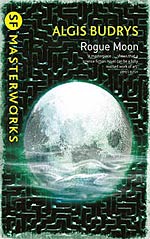
![]() Rhondak101
Rhondak101
1/5/2015
![]()
Published in 1959, long after the heyday of the hard-boiled novel, Algis Budrys' Rogue Moon projects the tone of a work by Dashiell Hammett or Raymond Chandler. The character conversations are full of the same enigmatic aggression one finds in Hammett and Chandler. Most of these conversations take place between the three male characters: Ed Hawks, the existential scientist; Al Harris, the romantic adventurer; and Vincent Connington, the classic antagonist, who wants to block the happiness and success of the other two. Of course, in the middle of these three, is the femme fatale, Claire Pack, who admits "I can't know a man more than a few minutes without trying to get under his skin" (105). Connington describes her as "an elemental--the rises of the tides, the coming of the seasons, an eclipse of the Sun" (107). Claire is one point of competition between the men, but there's certainly an excess of testosterone-driven competition in this book. While all three men are ostensibly working to the same goal, each conversation is fraught with unexplained aggression. This gets boring. Plus, there's just too much talking in general.
Yet, this is a science fiction novel. In short, it fits the Big Dumb Object trope. The big dumb object is a mysterious building on the dark side of the moon. Ed Hawks is in charge of the team trying to explore it. However, the method of exploration is not sending men to the moon in a rocket. Hawks had developed a method to send a copy of a person to the moon via radio waves. Each lunar copy meets a certain death in the building, causing his original back on earth to go insane. The beginning of the novel presents this problem, and Connington presents Al Harris as the solution. Al Harris courts death daily, through racing, climbing, parachuting. Harris, Connington believes, has the personality to die, come back, contribute to the knowledge pool, and then do it all again.
Budrys, through these characters and the big dumb object, underscores the randomness and meaninglessness of the universe. Harris is chosen to die over and over again, and Hawks conceives of himself as a serial murderer. When Hawks orients Harris about the "rules" of the structure, he says "'It is, for example, fatal to kneel on one knee while facing lunar north. It is fatal to raise the left hand above shoulder height while in any position whatsoever. It is fatal past a certain point to wear armor whose air hoses loop over the shoulders. It is fatal past another point to wear armor whose air tanks feed directly into the suit without the uses of hoses at all" (87). The structure is illogical, just like life. Its purpose, its goal seems to be to destroy. It symbolizes the belief that death attacks man each moment in varied and random ways.
The action in this novel is thin, and, as stated before, there are far too many conversations. However, in certain places the writing is crisp and meaningful. For example, there's a fabulous section in which Hawks compares their attempts to explore the structure to a beetle crawling into a tin can--the beetle understands nothing about the can's purpose or its makers. The beetle's view is limited to its knowledge and experience. This section relates to the ending, which I will not reveal here. The ending calls into question what it means to be human and the ways that experience makes each of us who we are.
Discussions of Hammett's The Maltese Falcon often discuss how the Maltese Falcon itself is a MacGuffin, a meanlingless plot device, in short, a little dumb object. This points to another similarity between Rogue Moon and the hardboiled novels: the structure on the moon is only a plot device that causes the characters to question their humanity and their mortality.